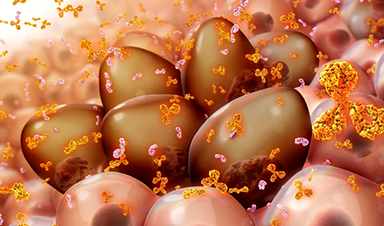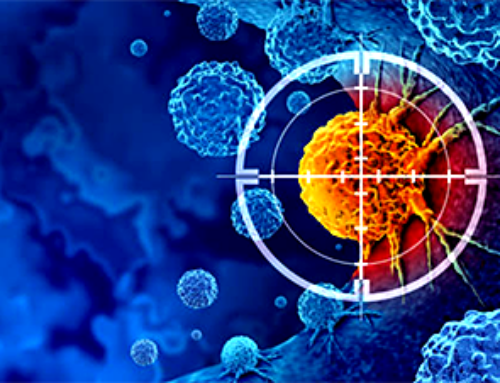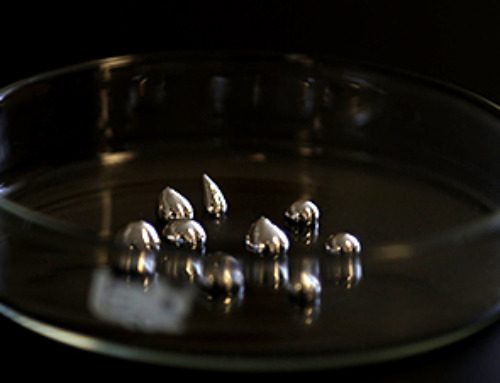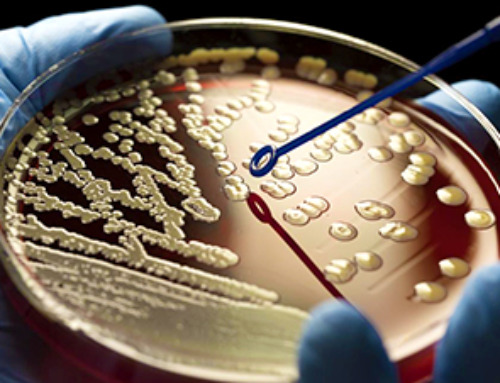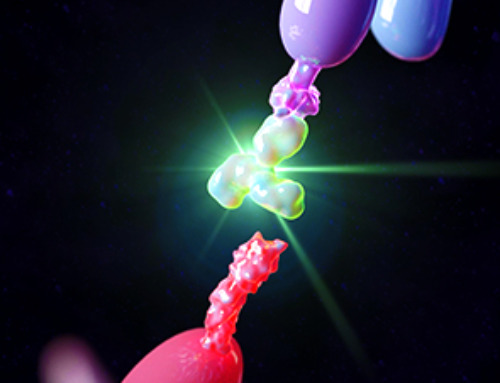| Multiple myeloma is an incurable bone marrow cancer that kills over 100,000 people every year. Known for its quick and deadly spread, this disease is one of the most challenging to address. As these cancer cells move through different parts of the body, they mutate, outpacing possible treatments. People diagnosed with severe multiple myeloma that is resistant to chemotherapy typically survive for only three to six months. Innovative therapies are desperately needed to prevent the spread of this disease and provide a fighting chance for those who suffer from it. | |
| Michael Mitchell, J. Peter and Geri Skirkanich Assistant Professor of Innovation in Bioengineering (BE), and Christian Figueroa-Espada, doctoral student in BE at the University of Pennsylvania School of Engineering and Applied Science, created an RNA nanoparticle therapy that makes it impossible for multiple myeloma to move and mutate. The treatment, described in their study published in PNAS (“In vivo bone marrow microenvironment siRNA delivery using lipid–polymer nanoparticles for multiple myeloma therapy”), turns off a cancer-attracting function in blood vessels, disabling the pathways through which multiple myeloma cells travel. |
| By shutting down this “chemical GPS” that induces the migration of cancer cells, the team’s therapy stops the spread of multiple myeloma, helping to eliminate it altogether. | |
| Endothelial cells, those that line blood vessels, produce a protein we need to survive. This protein, CyPA, is responsible for folding and transporting other proteins. It also activates T-cell responses when we get sick. | |
| However, when multiple myeloma is present, endothelial cells overexpress CyPA and secrete it into the blood vessels where its functions become malignant. Here, CyPA is a chemo-attractant, meaning it pulls multiple myeloma cells from the bone marrow into the blood vessels where they travel quickly to other bones in the body. | |
| “To stop the spread, we aimed to turn off this function of CyPA using RNA therapy, targeting the microenvironment of the cancer instead of the cancer cell itself,” says Mitchell. “But getting nucleic acids into the marrow was challenging due to the complex biological barriers.” | |
| To get the RNA into the hard-to-reach bone marrow, the team needed to redesign the traditional delivery vehicle for the lipid nanoparticle. | |
| “We designed a new hybrid nanoparticle that could deliver small interfering RNA (siRNA) to endothelial cells,” says Figueroa-Espada. “The siRNA stops cells from producing CyPA. When tested in vitro, the therapy prevented the spread of cancer cells. When tested in mice, both alone and in combination with chemotherapies, our therapy was able to decrease the size of tumors, extend survival rates and decrease the cancer’s resistance to chemotherapy.” | |
| “This work can help improve current treatments for multiple myeloma as well as other cancers that spread through the blood vessels,” adds Mitchell. “Using our platform for targeted nanoparticle development, we are looking forward to investigating other cancers and diseases where CyPA is overexpressed.” | |
| By creating a roadblock in cancer’s commute through the body, the Penn Engineering team is removing a longstanding barrier in the treatment of multiple myeloma, providing real hope for people diagnosed with this disease. | |
| In future work, the team plans to investigate silencing additional functions in the microenvironments of cancers to better overcome drug resistance, cancer initiation, and metastasis. They are currently working with Ruben Carrasco, Professor of Pathology at the Dana-Farber Cancer Institute and co-corresponding author of this study, to identify potential targets for this kind of therapy. Once RNA nanoparticle therapy is proven safe in larger animals, this proof-of-concept study can move forward to clinical trials. |
| Source: By Melissa Pappas, University of Pennsylvania (Note: Content may be edited for style and length) |
News
Repurposed drugs could calm the immune system’s response to nanomedicine
An international study led by researchers at the University of Colorado Anschutz Medical Campus has identified a promising strategy to enhance the safety of nanomedicines, advanced therapies often used in cancer and vaccine treatments, [...]
Nano-Enhanced Hydrogel Strategies for Cartilage Repair
A recent article in Engineering describes the development of a protein-based nanocomposite hydrogel designed to deliver two therapeutic agents—dexamethasone (Dex) and kartogenin (KGN)—to support cartilage repair. The hydrogel is engineered to modulate immune responses and promote [...]
New Cancer Drug Blocks Tumors Without Debilitating Side Effects
A new drug targets RAS-PI3Kα pathways without harmful side effects. It was developed using high-performance computing and AI. A new cancer drug candidate, developed through a collaboration between Lawrence Livermore National Laboratory (LLNL), BridgeBio Oncology [...]
Scientists Are Pretty Close to Replicating the First Thing That Ever Lived
For 400 million years, a leading hypothesis claims, Earth was an “RNA World,” meaning that life must’ve first replicated from RNA before the arrival of proteins and DNA. Unfortunately, scientists have failed to find [...]
Why ‘Peniaphobia’ Is Exploding Among Young People (And Why We Should Be Concerned)
An insidious illness is taking hold among a growing proportion of young people. Little known to the general public, peniaphobia—the fear of becoming poor—is gaining ground among teens and young adults. Discover the causes [...]
Team finds flawed data in recent study relevant to coronavirus antiviral development
The COVID pandemic illustrated how urgently we need antiviral medications capable of treating coronavirus infections. To aid this effort, researchers quickly homed in on part of SARS-CoV-2's molecular structure known as the NiRAN domain—an [...]
Drug-Coated Neural Implants Reduce Immune Rejection
Summary: A new study shows that coating neural prosthetic implants with the anti-inflammatory drug dexamethasone helps reduce the body’s immune response and scar tissue formation. This strategy enhances the long-term performance and stability of electrodes [...]
Scientists discover cancer-fighting bacteria that ‘soak up’ forever chemicals in the body
A family of healthy bacteria may help 'soak up' toxic forever chemicals in the body, warding off their cancerous effects. Forever chemicals, also known as PFAS (per- and polyfluoroalkyl substances), are toxic chemicals that [...]
Johns Hopkins Researchers Uncover a New Way To Kill Cancer Cells
A new study reveals that blocking ribosomal RNA production rewires cancer cell behavior and could help treat genetically unstable tumors. Researchers at the Johns Hopkins Kimmel Cancer Center and the Department of Radiation Oncology and Molecular [...]
AI matches doctors in mapping lung tumors for radiation therapy
In radiation therapy, precision can save lives. Oncologists must carefully map the size and location of a tumor before delivering high-dose radiation to destroy cancer cells while sparing healthy tissue. But this process, called [...]
Scientists Finally “See” Key Protein That Controls Inflammation
Researchers used advanced microscopy to uncover important protein structures. For the first time, two important protein structures in the human body are being visualized, thanks in part to cutting-edge technology at the University of [...]
AI tool detects 9 types of dementia from a single brain scan
Mayo Clinic researchers have developed a new artificial intelligence (AI) tool that helps clinicians identify brain activity patterns linked to nine types of dementia, including Alzheimer's disease, using a single, widely available scan—a transformative [...]
Is plastic packaging putting more than just food on your plate?
New research reveals that common food packaging and utensils can shed microscopic plastics into our food, prompting urgent calls for stricter testing and updated regulations to protect public health. Beyond microplastics: The analysis intentionally [...]
Aging Spreads Through the Bloodstream
Summary: New research reveals that aging isn’t just a local cellular process—it can spread throughout the body via the bloodstream. A redox-sensitive protein called ReHMGB1, secreted by senescent cells, was found to trigger aging features [...]
AI and nanomedicine find rare biomarkers for prostrate cancer and atherosclerosis
Imagine a stadium packed with 75,000 fans, all wearing green and white jerseys—except one person in a solid green shirt. Finding that person would be tough. That's how hard it is for scientists to [...]
Are Pesticides Breeding the Next Pandemic? Experts Warn of Fungal Superbugs
Fungicides used in agriculture have been linked to an increase in resistance to antifungal drugs in both humans and animals. Fungal infections are on the rise, and two UC Davis infectious disease experts, Dr. George Thompson [...]
